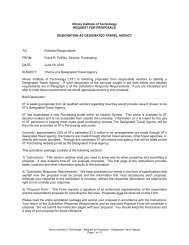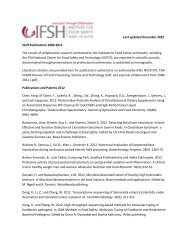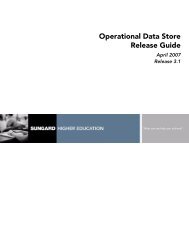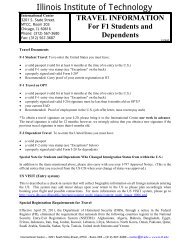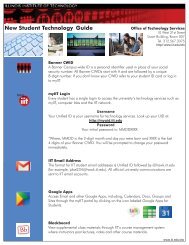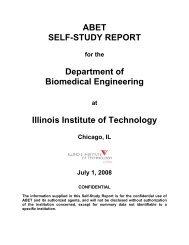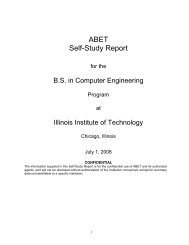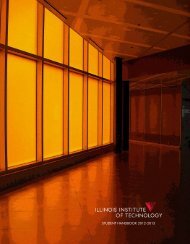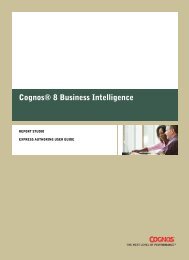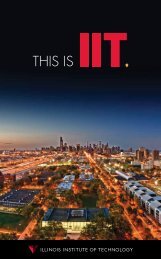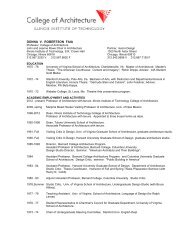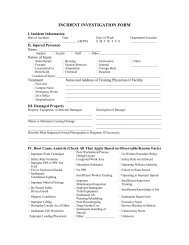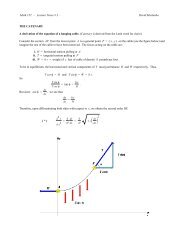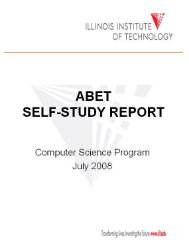Copyright & Disclaimer Information - Illinois Institute of Technology
Copyright & Disclaimer Information - Illinois Institute of Technology
Copyright & Disclaimer Information - Illinois Institute of Technology
You also want an ePaper? Increase the reach of your titles
YUMPU automatically turns print PDFs into web optimized ePapers that Google loves.
Course Descriptions<br />
engineering through a series <strong>of</strong> handson<br />
projects and computer exercises.<br />
Develops pr<strong>of</strong>essional communication<br />
and teamwork skills. (1-2-2) (C)<br />
ECE 101<br />
Introduction to the Pr<strong>of</strong>ession II<br />
Continuation <strong>of</strong> ECE 100, primarily<br />
through short projects. Prerequisite:<br />
ECE 100. (0-4-2) (C)<br />
ECE 211<br />
Circuit Analysis I<br />
Ohm’s Law, Kirchh<strong>of</strong>f’s Laws, and<br />
network element voltage-current<br />
relations. Application <strong>of</strong> mesh and<br />
nodal analysis to circuits. Dependent<br />
sources, operational amplifier circuits,<br />
superposition, Thevenin’s and Norton’s<br />
Theorems, maximum power transfer<br />
theorem. Transient circuit analysis for<br />
RC, RL and RLC circuits. Introduction<br />
to Laplace Transforms. Corequisite:<br />
MATH 252. Concurrent registration in<br />
ECE 212 and ECE 218 is strongly<br />
encouraged. (3-0-3)<br />
ECE 212<br />
Analog and Digital Laboratory I<br />
Basic experiments with analog and digital<br />
circuits. Familiarization with test and<br />
measurement equipment: combinational<br />
digital circuits; familiarization<br />
with latches, flip-flops and shift registers;<br />
operational amplifiers; and transient<br />
effects in first-order and second-order<br />
analog circuits; PSpice s<strong>of</strong>tware applications.<br />
Corequisites: ECE 211, ECE<br />
218. Concurrent registration in<br />
ECE 211 and ECE 218 is strongly<br />
encouraged. (0-3-1) (C)<br />
ECE 213<br />
Circuit Analysis II<br />
Sinusoidal excitation and phasors. AC<br />
steady-state circuit analysis using phasors.<br />
Complex frequency, network functions,<br />
pole-zero analysis, frequency response,<br />
and resonance. Two-port networks,<br />
transformers, mutual inductance, AC<br />
steady-state power, RMS values, introduction<br />
to three-phase systems, and<br />
Fourier series. Prerequisite: ECE 211.<br />
Concurrent registration in ECE 214 is<br />
strongly encouraged. (3-0-3)<br />
ECE 214<br />
Analog and Digital Laboratory II<br />
Design-oriented experiments including<br />
counters, finite state machines, sequen-<br />
<strong>Copyright</strong> & <strong>Disclaimer</strong> <strong>Information</strong>: <strong>Copyright</strong> © 1994, 1995, 1996, 1997, 1998, 1999, 2000, 2001, 2002, 2003, 2004, 2005, 2006, 2007. CollegeSource®, Inc. and Career Guidance Foundation. CollegeSource® digital catalogs are derivative works owned and copyrighted by CollegeSource®, Inc. and Career Guidance Foundation. Catalog content is owned and copyrighted by the appropriate school. While CollegeSource®, Inc. and Career Guidance Foundation provides information as a service to the public, copyright is retained on all digital catalogs.<br />
<strong>Copyright</strong> & <strong>Disclaimer</strong> <strong>Information</strong>: <strong>Copyright</strong> © 1994, 1995, 1996, 1997, 1998, 1999, 2000, 2001, 2002, 2003, 2004, 2005, 2006, 2007. CollegeSource®, Inc. and Career Guidance Foundation. CollegeSource® digital catalogs are derivative works owned and copyrighted by CollegeSource®, Inc. and Career Guidance Foundation. Catalog content is owned and copyrighted by the appropriate school. While CollegeSource®, Inc. and Career Guidance Foundation provides information as a service to the public, copyright is retained on all digital catalogs.<br />
tial logic design, impedances in AC<br />
steady-state, resonant circuits, two-port<br />
networks, and filters. A final project<br />
incorporating concepts from analog<br />
and digital circuit design will be<br />
required. Prerequisite: ECE 212.<br />
Corequisite: ECE 213. Concurrent<br />
registration in ECE 213 is strongly<br />
encouraged. (0-3-1) (C)<br />
ECE 218<br />
Digital Systems<br />
Number systems and conversions, binary<br />
codes, and Boolean algebra. Switching<br />
devices, discrete and integrated digital<br />
circuits, analysis and design <strong>of</strong> combinational<br />
logic circuits, Karnaugh maps and<br />
minimization techniques. Counters and<br />
registers. Analysis and design <strong>of</strong> synchronous<br />
sequential circuits. Prerequisite:<br />
Sophomore standing. Concurrent registration<br />
in ECE 2 11 and ECE 2 12 is<br />
strongly encouraged. (3-0-3)<br />
ECE 242<br />
Digital Computers and Computing<br />
Basic concepts in computer architecture,<br />
organization, and programming,<br />
including: integer and floating point<br />
number representations, memory organization,<br />
computer processor operation<br />
(the fetch/execute cycle), and computer<br />
instruction sets. Programming in<br />
machine language and assembly language<br />
with an emphasis on practical<br />
problems. Brief survey <strong>of</strong> different<br />
computer architectures. Prerequisites:<br />
CS 105, ECE 218. (3-0-3)<br />
ECE 307<br />
Electrodynamics<br />
Vector analysis applied to static and<br />
time-varying electric and magnetic<br />
fields. Coulomb’s Law, electric-field<br />
intensity, flux density and Gauss’s Law.<br />
Energy and potential. Biot-Savart and<br />
Ampere’s Law. Maxwell’s equations<br />
with applications including uniformplane<br />
wave propagation. Prerequisites:<br />
PHYS 221, MATH 251. (3-3-4)<br />
ECE 308<br />
Signals and Systems<br />
Time and frequency domain representation<br />
<strong>of</strong> continuous and discrete time<br />
signals. Introduction to sampling and<br />
sampling theorem. Time and frequency<br />
domain analysis <strong>of</strong> continuous and<br />
discrete linear systems. Fourier series,<br />
convolution, transfer functions. Fourier<br />
IIT Undergraduate Bulletin 1999-2001<br />
transforms, Laplace transforms, and<br />
Z-transforms. Prerequisites: ECE 213,<br />
MATH 333. (3-0-3)<br />
ECE 309<br />
Traveling Waves<br />
Analysis and design <strong>of</strong> circuits using<br />
distributed network elements. Response<br />
<strong>of</strong> transmission lines with linear and<br />
nonlinear loads to digital and transient<br />
signals. AC steady-state <strong>of</strong> lossless and<br />
lossy lines. The Smith Chart as an<br />
analysis and design tool. Impedance<br />
matching methods; transmission line<br />
transformers. Prerequisites: ECE 213,<br />
PHYS 221. (3-0-3)<br />
ECE 311<br />
Engineering Electronics<br />
Physics <strong>of</strong> semiconductor devices.<br />
Diode operation and circuit applications.<br />
Regulated power supplies.<br />
Bipolar and field-effect transistor operating<br />
principles. Biasing techniques and<br />
stabilization. Linear equivalent circuit<br />
analysis <strong>of</strong> bipolar and field-effect<br />
transistor amplifiers. Laboratory experiments<br />
reinforce concepts. Prerequisites:<br />
ECE 213, ECE 214. (3-3-4) (C)<br />
ECE 312<br />
Electronic Circuits<br />
Analysis and design <strong>of</strong> amplifier circuits.<br />
Frequency response <strong>of</strong> transistor amplifiers.<br />
Feedback amplifiers. Operational<br />
amplifiers: internal structure, characteristics<br />
and applications. Stability and<br />
compensation. Laboratory experiments<br />
reinforce concepts. Prerequisite:<br />
ECE 311. (3-3-4) (C)<br />
ECE 319<br />
Fundamentals <strong>of</strong> Power Engineering<br />
Principles <strong>of</strong> electromechanical energy<br />
conversion. Fundamentals <strong>of</strong> the operation<br />
<strong>of</strong> transformers, synchronous<br />
machines, induction machines, and<br />
fractional horsepower machines.<br />
Introduction to power network models<br />
and per-unit calculations. Gauss-Siedel<br />
load flow. Lossless economic dispatch.<br />
Symmetrical three-phase faults.<br />
Laboratory considers operation, analysis<br />
and performance <strong>of</strong> motors and generators.<br />
The laboratory experiments also<br />
involve use <strong>of</strong> PC-based interactive<br />
graphical s<strong>of</strong>tware for load flow, economic<br />
dispatch, and fault analysis.<br />
Prerequisites: ECE 213, ECE 214,<br />
PHYS 221. (3-3-4) (C)



